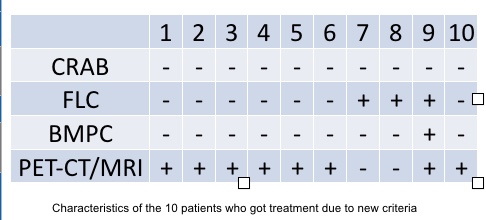
Contributions
Abstract: PB2021
Type: Publication Only
Background
Diagnostic criteria for Symptomatic Multiple Myeloma (MM) Published in 2003 by the International Myeloma Working Group(IMWG'03) established for the presence of a bone Marrow infiltration by plasma cells (BMPC) in any percentage And / or the presence of a monoclonal component of any amount Along with the presence of signs or symptoms of organ damage (CRAB) attributable to the proliferation of plasma cells.
Due to 'CRAB redefined' and / or the presence of markers of Rapid progression to 'classical-symptomatic' MM criteria.
Aims
There are few information about real-life statistics in NDMM according to new criteria to initiate treatment.
Methods
We have performed a retrospective analysis with all new MM cases diagnosed from Dec-2014 (after new criteria were published) to Feb-2017 (28 months).
55 patients were diagnosed of MM. 26 were male and 29 female. The median age at diagnosis was 74 years (52-87), 11 were under 65 (U65) and 44 were over 65 (O65).
Results
3 were diagnosed after biopsy of plasmacytomas. None of them have Bone Marrow (BM) infiltration but with criteria of MM after PET-CT multitopic involvement.
7 of these NDMM were smoldering MM (sMM). All of then completed initial staging with more sensitive imaging tests than conventional radiology (MRI and / or PET-CT)

Conclusion
One of the hypotheses for introducing new criteria for initiating treatment was that the initiation of adequate and early treatment may improve the prognosis of patients with symptomatic NDMM.
Session topic: 14. Myeloma and other monoclonal gammopathies - Clinical
Keyword(s): epidemiology
Abstract: PB2021
Type: Publication Only
Background
Diagnostic criteria for Symptomatic Multiple Myeloma (MM) Published in 2003 by the International Myeloma Working Group(IMWG'03) established for the presence of a bone Marrow infiltration by plasma cells (BMPC) in any percentage And / or the presence of a monoclonal component of any amount Along with the presence of signs or symptoms of organ damage (CRAB) attributable to the proliferation of plasma cells.
Due to 'CRAB redefined' and / or the presence of markers of Rapid progression to 'classical-symptomatic' MM criteria.
Aims
There are few information about real-life statistics in NDMM according to new criteria to initiate treatment.
Methods
We have performed a retrospective analysis with all new MM cases diagnosed from Dec-2014 (after new criteria were published) to Feb-2017 (28 months).
55 patients were diagnosed of MM. 26 were male and 29 female. The median age at diagnosis was 74 years (52-87), 11 were under 65 (U65) and 44 were over 65 (O65).
Results
3 were diagnosed after biopsy of plasmacytomas. None of them have Bone Marrow (BM) infiltration but with criteria of MM after PET-CT multitopic involvement.
7 of these NDMM were smoldering MM (sMM). All of then completed initial staging with more sensitive imaging tests than conventional radiology (MRI and / or PET-CT)

Conclusion
One of the hypotheses for introducing new criteria for initiating treatment was that the initiation of adequate and early treatment may improve the prognosis of patients with symptomatic NDMM.
Session topic: 14. Myeloma and other monoclonal gammopathies - Clinical
Keyword(s): epidemiology


